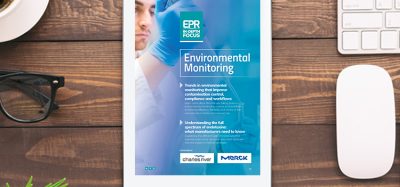Article 2: The implementation of rapid microbiological methods
Posted: 9 May 2010 |
This is the second in a series of articles on rapid microbiological methods that will appear in European Pharmaceutical Review during 2010. Method validation is the process used to confirm that an analytical procedure employed for a specific test is reliable, reproducible and suitable for its intended purpose. All analytical methods need to be validated prior to their introduction into routine use and this is especially true for novel technology platforms such as rapid microbiological methods (RMMs).


This is the second in a series of articles on rapid microbiological methods that will appear in European Pharmaceutical Review during 2010. Method validation is the process used to confirm that an analytical procedure employed for a specific test is reliable, reproducible and suitable for its intended purpose. All analytical methods need to be validated prior to their introduction into routine use and this is especially true for novel technology platforms such as rapid microbiological methods (RMMs).
Because many RMM technologies consist of a combination of instrumentation, software, consumables and reagents, in addition to specific detection, quantitative or identification methodologies, it is important to develop a comprehensive and holistic approach to the validation process to ensure that the entire RMM system is suitable for its intended use. The following sections provide a brief overview of how to design a meaningful validation program in order to effectively demonstrate that the new RMM is suitable for its intended use and is equivalent to, or better than, the existing method you intend to replace.
Initial activities
Prior to purchasing and validating a RMM, there are a number of due diligence activities that should be undertaken. These may include a thorough understanding of the scientific needs of the RMM, the technical benefits the RMM possesses as compared with the existing method, regulatory impact, economic advantages and the role of the RMM supplier in terms of providing support during the initial assessment, validation exercises and most importantly, after the system has been placed in service for routine use.
From a scientific perspective, it is important to understand what technical capabilities are required, including, but not limited to, method sensitivity and specificity (e.g., detection levels and for what types of microorganisms), sample throughput, sample type, automation, data handling and archiving, report management, if the system needs to meet 21 CFR Part 11 expectations and the required degree of operator training.
Proof-of-concept or feasibility testing can be performed to determine if incompatibilities exist between the RMM and the intended product or test sample(s). These types of studies can also be performed in the event that the RMM supplier has little or no data on testing similar product or test materials. This can be accomplished using a rental or loaner instrument, or by sending samples directly to the supplier for evaluation. The data obtained from these initial studies will help with the decision to purchase the RMM and proceed with formal validation activities.
The due diligence process also involves a review of existing regulatory commitments and whether implementing the RMM will result in significant changes that will require a formal submission. Additionally, a financial assessment of the costs (and cost savings) associated with the purchase, validation and implementation of the RMM should be performed.
Finally, the selection of a RMM supplier is just as important as the RMM itself and it is important to have a thorough understanding of the supplier’s technical capabilities and their ability to support each phase of the validation process, as well as continuing assistance once the RMM is placed into service.
In order to design a holistic approach to RMM validation, it is necessary to develop a comprehensive strategy that includes qualifying not only the RMM instrumentation but the analytical method as well. The validation plan can be comprised of a number of process steps and these are outlined below.
Risk assessment
A risk assessment should be performed prior to the start of any RMM validation activities. Identified risks will vary depending on the RMM technology and the RMM supplier, the method the RMM is intended to replace, the product or sample(s) for evaluation, whether the new measurements are qualitative or quantitative, if the resulting data is significantly different from the existing method, method variability, method robustness, pharmacopeial equivalence, regulatory acceptance and other attributes.
User Requirements Specifications (URS)
When choosing a RMM, the end-user must first establish the basic expectations that the system must meet. For example, the system may have to detect and enumerate bacteria, fungi and spores, have a sensitivity level of a single viable cell, process at least 80 samples within an eight hour shift and show (at least) equivalent results to the current method. From here, the user can develop specific requirements for the entire RMM system, including the equipment and the analytical method, which will demonstrate that the system performs as expected. The document that describes the functions and characteristics that the RMM system must be capable of performing is called the URS. The requirements specified in the URS can also form the basis for all of the validation testing requirements, test protocols and acceptance criteria.
Functional Design Specifications (FDS)
The FDS is the document that describes all of the functions and requirements for the RMM system and what will be tested to ensure that the system performs as specified in the URS. The FDS can be quite extensive, covering system functionality, configuration, input/outputs, environment, utilities, architecture, interfaces, data and security. Additionally, the FDS will point to specific test scripts where each requirement will be tested and verified against preestablished acceptance criteria. These test scripts are normally contained within the Installation, Operational and Performance Qualification protocols.
Installation Qualification (IQ)
The IQ establishes that the equipment is received as designed and specified, that it is properly and safely installed with the correct utilities in the selected environment and that the environment is suitable for the operation and use of the equipment. Basically, the IQ verifies that the equipment was received and meets the design specifications for the equipment that was ordered. The IQ can be carried out by the RMM supplier or by the end-user.
Operational Qualification (OQ)
The OQ provides documented verification that the equipment, as installed in the selected environment, performs effectively and reproducibly as intended throughout the anticipated or representative operational ranges, defined limits and tolerances. During this phase of the validation test plan, the end-user may confirm their previous proof-of-concept testing and/or the RMM supplier’s supporting data. The OQ is also the focal point for the majority of the computer system, software and security validation activities, as well as demonstrating that the microbiological method is appropriate for its intended application. The latter is usually accomplished using standardised microorganism cultures and test samples/product matrices, where the validation recommendations provided by the Parenteral Drug Association (PDA)1, the United States Pharmacopoeia (USP)2 and the European Pharmacopoeia (Ph. Eur.)3 are normally followed.
The PDA provided the first true guidance on RMMs, Technical Report #33, ‘Evaluation, Validation and Implementation of New Micro – biological Testing Methods.’ Published in 2000, this document provides information on validation protocol design, testing and acceptance criteria, and installation, operational, and performance qualification strategies.
USP informational chapter , Validation of Alternative Microbiological Methods, provides guidance for the validation of methods for use as alternatives to official compendial microbiological methods. The chapter incorporates the analytical concepts from USP , Validation of Compendial Methods and relates these to alternative quantitative and qualitative microbiological systems. Although there is no guidance on qualifying new microbial identification systems, the USP has recently published a separate draft informational chapter on this topic.
Ph. Eur. chapter 5.1.6, Alternative Methods for Control of Microbiological Quality, describes alternative methods for the control of micro – biological quality. A discussion of qualitative, quantitative and identification tests and guidance for using validation criteria are provided. Additionally, technology overviews including risk-benefit analysis and an annex describing an example of a detailed protocol for the validation of an alternative method using bioluminescence techniques have been proposed.
Performance Qualification (PQ)
The PQ provides confirmation that the entire RMM system performs as it is intended to by using actual product and/or test samples in order to demonstrate equivalence to the existing or reference method. This may include running the RMM in parallel with the current method for a specified period of time or number of batches or samples. Test samples should be identified, when appropriate, that are expected to contain microorganisms and some samples that are not, in order to test the suitability of the RMM. At least three independent tests using at least three different lots/batches of the test sample should be assessed. The actual number of batches, replicates, sample size and/or duration of testing will be defined as a function of the application.
A statistical analysis of the resulting data should be conducted in order to demonstrate equivalency between the two methods. There is the possibility that the RMM may recover a higher number of microorganisms as some technologies are not dependant on the growth of microorganisms, and cells that are physiologically stressed and/or damaged may not be detected on conventional, growth-based media. Furthermore, the RMM may report the detection of viable microorganisms as a completely different measurement than colony forming units (CFUs), such as fluorescent units, relative light units or genetic copy number. In this case, a strategy should be developed for determining the correlation of the new data with the existing method’s data, and whether there may be an impact to existing acceptance levels or in-process/product specifications.
Summary
Once the validation plan has been executed and approved, the rapid method may be implemented for routine use. Each type of rapid method and its intended application will most likely require a separate validation strategy; therefore, it is important to carefully consider all of the activities that will be required to demonstrate that the RMM instrumentation and the method is appropriately qualified and suitable for its intended use.
References
- PDA Journal of Pharmaceutical Science and Technology. Supplement 54(3). Parenteral Drug Association, Bethesda, Maryland: 2000
- General Information Chapter , Validation of alternative microbiological methods. USP 32-NF27, U.S. Pharmacopeial Convention, Rockville, Maryland: 2009
- Informational chapter 5.1.6. Alternative methods for control of microbiological quality. European Pharmacopoeia 6.4, European Directorate for the Quality of Medicines (EDQM), Strasbourg, France: 2009
About the author
Dr. Michael J. Miller is an internationally recognised microbiologist and subject matter expert in pharmaceutical microbiology and the design, validation and implementation of rapid microbiological methods. He is currently the President of Microbiology Consultants, LLC (http://microbiologyconsultants.com). In this role, he is responsible for providing scientific, quality, regulatory and business solutions for the pharmaceutical industry and suppliers of new microbiology technologies. Over the past 21 years, Dr. Miller has held numerous R&D, manufacturing, quality, consulting and business development leadership roles at Johnson & Johnson, Eli Lilly and Company, Bausch & Lomb, and Pharmaceutical Systems, Inc.
Dr. Miller has authored over 100 technical publications and presentations in the areas of rapid microbiological methods, PAT, ophthalmics, disinfection and sterilisation, and is the editor of PDA’s Encyclopedia of Rapid Microbiological Methods. He currently serves on a number of PDA’s program and publication committees and advisory boards, and is co-chairing the revision of PDA Technical Report #33: Evaluation, Validation and Implementation of New Microbiological Testing Methods.
Dr. Miller holds a Ph.D. in Microbiology and Biochemistry from Georgia State University (GSU), a B.A. in Anthropology and Sociology from Hobart College, and is currently an adjunct professor at GSU. He was appointed the John Henry Hobart Fellow in Residence for Ethics and Social Justice, awarded PDA’s Distinguished Service Award and was named Microbiologist of the Year by the Institute of Validation Technology (IVT).
email: [email protected]









